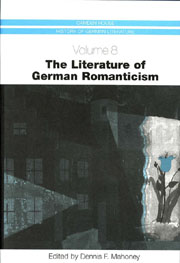Book contents
- Frontmatter
- Contents
- Illustrations
- Acknowledgments
- Abbreviations
- Introduction
- From “Romantick” To “Romantic”: The Genesis of German Romanticism in Late Eighteenth-Century Europe
- Goethe and the Romantic
- Early Romanticism
- From Goethe's Wilhelm Meister to anti-Meister Novels: The Romantic Novel between Tieck's William Lovell and Hoffmann's Kater Murr
- Tales of Wonder and Terror: Short Prose of the German Romantics
- The Romantic Drama: Tieck, Brentano, Arnim, Fouqué, and Eichendorff
- German Romantic Poetry in Theory and Practice: The Schlegel Brothers, Schelling, Tieck, Novalis, Eichendorff, Brentano, and Heine
- The Turn to History and the Volk: Brentano, Arnim, and the Grimm Brothers
- History and Moral Imperatives: The Contradictions of Political Romanticism
- Romanticism and Natural Science
- Gender Studies and Romanticism
- The Romantic Preoccupation with Musical Meaning
- Romanticism and the Visual Arts
- Goethe's Late Verse
- The Reception of German Romanticism in the Twentieth Century
- Works Cited
- Notes on the Contributors
- Index
Romanticism and the Visual Arts
Published online by Cambridge University Press: 05 February 2013
- Frontmatter
- Contents
- Illustrations
- Acknowledgments
- Abbreviations
- Introduction
- From “Romantick” To “Romantic”: The Genesis of German Romanticism in Late Eighteenth-Century Europe
- Goethe and the Romantic
- Early Romanticism
- From Goethe's Wilhelm Meister to anti-Meister Novels: The Romantic Novel between Tieck's William Lovell and Hoffmann's Kater Murr
- Tales of Wonder and Terror: Short Prose of the German Romantics
- The Romantic Drama: Tieck, Brentano, Arnim, Fouqué, and Eichendorff
- German Romantic Poetry in Theory and Practice: The Schlegel Brothers, Schelling, Tieck, Novalis, Eichendorff, Brentano, and Heine
- The Turn to History and the Volk: Brentano, Arnim, and the Grimm Brothers
- History and Moral Imperatives: The Contradictions of Political Romanticism
- Romanticism and Natural Science
- Gender Studies and Romanticism
- The Romantic Preoccupation with Musical Meaning
- Romanticism and the Visual Arts
- Goethe's Late Verse
- The Reception of German Romanticism in the Twentieth Century
- Works Cited
- Notes on the Contributors
- Index
Summary
It was in Germany where Romantic visual art first emerged in the years between 1796 and 1830. This time span can be conventionally structured into three distinct currents: Frühromantik (Early Romanticism, 1796–1806), Hochromantik (High Romanticism, 1806–15), and Spätromantik (Late Romanticism, 1815–30). While the boundaries between each are frequently indistinct and the currents themselves are sometimes hard to distinguish, the periodization applied to German Romantic art coincides for the most part with that accorded German Romantic literature, although their centers of activity do not specifically coincide.
German Romanticism is often contrasted to Weimar Classicism. Goethe had serious objections to Romanticism and categorically rejected significant works of art, even by the painters since recognized as major figures, including Philipp Otto Runge (1777–1810) and Caspar David Friedrich (1774– 1840). Romanticism was opposed by the Propyläen (1798–1800) venture, a learned periodical published by Goethe, Johann Heinrich Meyer, Wilhelm von Humboldt, Karoline von Humboldt, and Schiller. They also organized many art competitions to promote classical ideals and to denigrate Romanticism, a movement that was nevertheless rising and eventually could not be stopped. In this chapter it will be argued that German Romanticism has suffered a double stigmatism in its reception history, due first to the dominant Goethe reception, which associated Romanticism with self-indulgence, extreme subjectivity, neglect of the objective, and ultimately madness. This strand of reception history was also strengthened by the Hegelian criticism of Romanticism in the name of so-called realism.
- Type
- Chapter
- Information
- The Literature of German Romanticism , pp. 273 - 306Publisher: Boydell & BrewerPrint publication year: 2003



